Brooks FireTracker FT2GAS User manual
- Category
- Fire protection
- Type
- User manual
This manual is also suitable for

Operation / Technical Manual
FT2GAS
Rev 1.3
Gaseous Extinguishing System
FT2GAS
M320 Dec 2019

FT2GAS Gaseous Extinguishing System
Rev No. 1.3
2

FT2GAS Gaseous Extinguishing System
Rev No. 1.3
3
Liability Disclaimer
Brooks shall not under any circumstances, except were otherwise required by law, be liable for any
incidental or consequential damages arising from loss of property or other damages or losses owing to
the failure of Brooks products beyond the cost of repair or replacement of any defective products.
Brooks reserves the right to make product improvements and change product specifications at any time.
While every precaution has been taken during the preparation of this manual to ensure the accuracy of
its contents, Brooks assumes no responsibility for errors or omissions.
READ AND OBSERVE THE FOLLOWING WARNINGS PRIOR TO OPERATING THE CIE
WARNING!
Improperly operating the CIE may cause serious consequences including fatal injury,
personal harm, damage or loss of property and equipment and interruption to the site normal
functions.
Contact the Fire Brigade immediately in the case of a fire alarm regardless of whether the
CIE supports fire alarm routing equipment or automatic fire protection equipment.
Always perform installation, maintenance and service by a qualified and trained personnel in
accordance with all the relevant standards and regulations.
Always install and operate in accordance with Brooks equipment instructions.
Any controls provided by the CIE are for fire protection purposes only. Do not rely on the CIE
to operate external equipment for any other purposes.
Activate the Service Master Abort switch (CIE) and the gas lock-off valve (gas system pipe-
work) to safely disable the system before and during any system maintenance which requires
the disablement of the gas release.
The Brooks CIE monitors the wiring conditions by using the end of line devices. However, it
is not capable of detecting the internal conditions of any associated external equipment
unless the system is specially arranged to monitor those conditions. The external equipment
shall be operated and maintained according to its own specific operation and maintenance
procedures.

FT2GAS Gaseous Extinguishing System
Rev No. 1.3
4
Table of Contents
1. About this Manual ............................................................................................................................. 8
1.1 Purpose ..................................................................................................................................... 8
1.2 Referenced Documents ............................................................................................................ 8
2. FT2GAS TECHNICAL DESCRIPTIONS .......................................................................................... 9
2.1 System Overview ...................................................................................................................... 9
2.2 Features .................................................................................................................................. 10
2.3 Specifications .......................................................................................................................... 11
2.4 Operation ................................................................................................................................. 12
2.4.1 Display Layout ................................................................................................................. 12
2.4.2 System Controls ............................................................................................................... 13
2.4.3 Buzzer & LED Indicating Patterns ................................................................................... 14
2.4.4 System Indications ........................................................................................................... 14
2.4.5 Fault Indications ............................................................................................................... 15
2.5 CIE Inputs and Outputs ........................................................................................................... 17
2.5.1 Fire Detection Zone Inputs............................................................................................... 17
2.5.1.1 ZONE INPUT CIRCUIT SPECIFICATIONS ................................................................. 17
2.5.1.2 ZONE INPUTS COMPATIBLE ACTUATING DEVICES .............................................. 17
2.5.2 Control Input and Output.................................................................................................. 18
2.5.2.1 Non Supervised Outputs .............................................................................................. 18
2.5.2.2 Alarm Devices Output .................................................................................................. 18
2.5.2.3 Extinguishing System Inoperative Sign Output ............................................................ 18
2.5.2.4 Fire Alarm / Do Not Enter and Evacuate Signs Output ................................................ 19
2.5.2.5 Gas Discharge Output .................................................................................................. 19
2.5.2.6 External Supervised Inputs .......................................................................................... 19
2.5.2.7 Local Control Station (LCS).......................................................................................... 20
2.5.2.8 External Buzzer ............................................................................................................ 21
2.5.2.9 DIP Switch Configurations............................................................................................ 21
2.6 Power Supply Unit (PSU) ........................................................................................................ 23
2.6.1 PSU Specifications .......................................................................................................... 23
2.6.2 PSU Supervision .............................................................................................................. 24
2.6.3 PSU Current Calculations ................................................................................................ 24
3. Installation and commissioning ...................................................................................................... 25
3.1 Visual Inspection Checklists .................................................................................................... 25
3.2 Resistance Check ................................................................................................................... 25
3.3 Functional Testing ................................................................................................................... 26
3.3.1 FT2 System Test .............................................................................................................. 26
3.3.1.1 Power Supply Check .................................................................................................... 26
3.3.1.2 Alarm Test .................................................................................................................... 26
3.3.2 Gas Extinguishing System Test ....................................................................................... 27
3.3.3 Local Control Station (LCS) Test ..................................................................................... 27
3.3.4 Fault Test ......................................................................................................................... 28
4. APPENDICES ................................................................................................................................ 29
4.1 Appendix A - Connections ....................................................................................................... 29
4.1.1 FT2 Main Control Board ................................................................................................... 29
4.1.2 FT2 Gas Extinguishing Control Board ............................................................................. 31
4.1.3 Warning Signs PCB Layout ............................................................................................. 33
4.1.4 Local control station ......................................................................................................... 35
4.2 Appendix B – System Fuse Details ......................................................................................... 36
4.3 Appendix C - Cable Types and Calculations .......................................................................... 37

FT2GAS Gaseous Extinguishing System
Rev No. 1.3
5
4.3.1 General Requirement ....................................................................................................... 37
4.3.2 Real Cable Resistance .................................................................................................... 37
4.3.3 Zone Cable ...................................................................................................................... 37
4.3.4 Output Cable .................................................................................................................... 38
4.3.5 Requirements and Reference Cable Types..................................................................... 38
4.4 Appendix D – Power & Battery Calculation Spreadsheet ....................................................... 39
4.5 Appendix E – Commissioning Record .................................................................................... 42
4.6 Appendix F – Equipment Record ............................................................................................ 44
4.7 Appendix G – Maintenance Record ........................................................................................ 45
4.8 Appendix H –Spare Parts List ................................................................................................. 46
4.9 Appendix I Data Sheets .......................................................................................................... 47
4.9.1 FT2GAS Gas Extinguishing System Control Panel ......................................................... 47
4.9.2 Warning Signs .................................................................................................................. 48
4.9.3 Local Control Station BLC1.............................................................................................. 50
4.9.4 24V Tone and Voice Sounders ........................................................................................ 51
4.9.5 Gas Strobe Interface (SUB938) ....................................................................................... 53
5. BLOCK WIRING DIAGRAM ........................................................................................................... 55
Table of Figures
Figure 1 Gaseous Extinguishing System Overview 9
Figure 2 Dual Gaseous Extinguishing System Display Layouts 12
Figure 3 Zone Input Circuit 17
Figure 4 Typical Relay or Sounder Control Circuit 18
Figure 5 Typical Gas Discharge Output Control Circuit 19
Figure 6 Supervised Input Circuit 20
Figure 7 Remote Station Input Circuit 20
Figure 8 External Buzzer Circuit 21
Figure 9 FT2 Control board PCB Layout (SUB922) 29
Figure 10 Gas Control board PCB Layout (SUB928) 31
Figure 11 Brooks Warning Signs PCB Layout 33
Figure 12 (Photograph 2) Rear of Local Control Station 35
Figure 13 Local Control Station Schematics 35
Figure 14 Gas Extinguishing Control Panel 47
Figure 15 Extinguishing System Warning Signs 48
Figure 16 Local Control Station BLCS1 50
Figure 17 Brooks Electronic Sounders 51
Figure 18 Dual Strobe Driver Board SUB938 53
Figure 19 FT2GAS Block Wiring Diagram 55
Figure 20 FT2GAS Warning Signs Connection Diagram 56
Figure 21 Warning Sign with Voice and Timer connection 57

FT2GAS Gaseous Extinguishing System
Rev No. 1.3
6
List of Tables
Table 1 General Specifications .............................................................................................................. 11
Table 2 System Controls ....................................................................................................................... 13
Table 3 Buzzer Indicating Patterns ........................................................................................................ 14
Table 4 LED Flash Patterns .................................................................................................................. 14
Table 5 System Indicating LEDs and flash Pattern ............................................................................... 14
Table 6 Display Fault LED Indications ................................................................................................... 15
Table 7 Gas Control board Fault LED Indications ................................................................................. 16
Table 8 Zone Input................................................................................................................................. 17
Table 9 Compatible devices .................................................................................................................. 17
Table 10 FT2 Control Board (SUB922) DIP (4 way) Switch SW1 Configuration .................................. 21
Table 11 Gas Control Board (SUB928) DIP Switch (8 way) SW1 Configuration .................................. 22
Table 12 Basic mains power supply requirement .................................................................................. 23
Table 13 Power Supply Supervision Characteristics ............................................................................. 24
Table 14 FT2 Control Board Connections ............................................................................................. 30
Table 15 Gas Control board Connections ............................................................................................. 32
Table 16 Warning Signs DIP Switch Setting ......................................................................................... 33
Table 17 Extinguishing System Warning Signs Connections................................................................ 34
Table 18 Local control station connection ............................................................................................. 35
Table 19 Fuse Specifications ................................................................................................................ 36
Table 20 Cable Resistance of the Reference Cables ........................................................................... 37
Table 21 Cable Types for Different Connections .................................................................................. 38
Table 22 Table of current consumption ................................................................................................. 39
Table 23 Resistance Check ................................................................................................................... 42
Table 24 Pre-commissioning Battery Cell Voltage Measurement Record ............................................ 43
Table 25 Power ON AC/DC Power Supply Calibration Record ............................................................ 43
Table 26 Equipment record ................................................................................................................... 44
Table 27 Maintenance record ................................................................................................................ 45
Table 28 FT2GAS panel parts ............................................................................................................... 46
Table 29 Local Control Station parts ..................................................................................................... 46
Table 30 Warning Signs parts ............................................................................................................... 46
Table 31 Warning Signs Specifications ................................................................................................. 49
Table 32 Warning Signs Operation Mode ............................................................................................. 49
Table 33 Polarity state sequence for Warning Signs ............................................................................ 54
Table 34 Required polarity state sequence for Strobes ........................................................................ 54

FT2GAS Gaseous Extinguishing System
Rev No. 1.3
7
DOCUMENT HISTORY
Issue Date Description
S/W
Version
Written By Checked By
Draft 10/12/07 Original Document. Draft W. Zhong A. Shenouda
1.0 20/3/09 Updated after reviewing V1.0 W. Zhong A. Shenouda
1.1 23/11/11
Add sounders datasheet & update table 9.
Review & correct, all label to all figures, correct
calculation example in Appendix D.
V1.0 W. Zhong E. Thein
1.2 15/7/13
Modify the table for Gas Control Board
(SUB928) DIP Switch (8 ways) SW1
Configuration. Bit 5 is reused to select whether
the gas discharged sensor input activates the
alarm conditions
V1.2 W. Zhong A. Shenouda
1.3 3/12/19
Update document, drawings, logo and add
warning signs with voice & speaker
V1.2 A.S. A.S.
Documentation Feedback
If you have any comments or suggestions regarding this manual, please contact Brooks Technical
Services.
We welcome your valuable feedback to further improve our future manuals.
Please include the following information:
• Product name and version number (if applicable)
• Manual part number and revision (found on the front cover)
• Page number
• Brief description of the content which you think should be improved or corrected
• Suggestions for improvement
Send email messages to:
technicalsupport@brooks.com.au
Please note the email address above is for documentation feedback only. If you have any technical
issues, please visit our web site www.brooks.com.au
and follow the links to the “Technical Support” or
“Enquiry” pages or contact your nearest branch.

FT2GAS Gaseous Extinguishing System
Rev No. 1.3
8
1. ABOUT THIS MANUAL
1.1 Purpose
This manual is designed to be the reference point for the Brooks Dual Zone Gaseous Control System
and provides the technical and operational instructions to the installer / user. The document is intended
to be used by the end user, service and commissioning personnel. It provides detailed information
required for installation, commissioning and operation.
The manual provides the following details for the Brooks Gaseous Extinguishing System:
• Technical instructions
• Operating instructions
• Indicators and controls
• Input and output cabling and connectivity.
• Power supply calculation documents
• Datasheets
• Block wiring diagrams
1.2 Referenced Documents
AS7240.2 Fire detection and alarm systems
Part 2: Control and indicating equipment (ISO7240-2:2003, MOD)
AS7240.4 Fire detection and alarm systems
Part 4: Power supply equipment (ISO7240-4:2003, MOD)
NZS4512-2003 New Zealand Standard
Fire Detection and Alarm Systems in Buildings
AS4214-2002 Australian Standard
Gaseous fire extinguishing systems
AS1670.1-2015 Fire detection, warning, control and intercom systems-System
Design and commissioning – Part 1: Fire
AS/NZS 3000-2007 Australian / New Zealand Standard
Electrical Installations (Known as Australian/New Zealand Wiring Rules)

FT2GAS Gaseous Extinguishing System
Rev No. 1.3
9
2. FT2GAS TECHNICAL DESCRIPTIONS
2.1 System Overview
A typical Brooks FT2GAS system is comprised of the following:
• Brooks FT2 Dual Zone control board (SUB922) and Zone Display Board (SUB923)
• Brooks Gas Extinguishing Control board (SUB928) and Gas Display board (SUB929).
• Switch Mode AC/DC Power Supply and backup batteries
• A combination of Brooks System Warning Signs
• Brooks Local Control Stations
• Brooks Dual Strobe Modules
• Brooks voice / tone warning speakers
• Optional Panasonic web server for remote monitoring of the system.
Figure 1 below illustrates some of the various components of the system.
Figure 1 Gaseous Extinguishing System Overview
The FT2 Dual Zone control board (SUB922) and the Zone Display Board (SUB923) shown in Figure 1
forms the two-zone fire panel functions that meets the requirements of the Australian Standards
AS7240.2 & AS7240.4. In addition, the board provides RS232 output to connect to an optional web
server for remote monitoring over Ethernet.
The plug-in Gas Control Board (SUB928) and the Gas Display Board (SUB929) in Figure 1 are designed
to provide the control and monitoring of a complete gaseous extinguishing system that meets the
requirements of the relevant clauses of the Australian extinguishing standard AS4214.
The standard FT2GAS system is fitted with a 150 Watt switch mode power supply (5A @ 28V) and can
house up to 2x12Ah sealed lead acid (SLA) batteries. A battery and power supply calculation should be

FT2GAS Gaseous Extinguishing System
Rev No. 1.3
10
performed to verify the suitability of this standard product for use in the intended application, refer to
Appendix D on page 39.
2.2 Features
The Brooks dual zone gaseous extinguishing control system has the following features:
• An intelligent dual microprocessor system which combines both the two zone CIE functions and
the dual zone gas controller functions.
• Fully supervised power supply to meet the requirements of the Australian standard AS7240.4.
• Intuitive indication and controls via the well-grouped LED indicators and momentary switches.
• Fully supervised input circuits, including two fire detection zone inputs, one gas lock-off valve
input, one manual release input and one gas discharged sensor input.
• Fully supervised system inoperative warning sign 24V output rated @ 0.5A maximum.
• Fully supervised 2 wire system outputs for level 1 and level 2 alarms to Brooks warning signs
(Level 1: alarm 1 [+/-] & Level 2: alarm 2 [-/+]) rated @ 3A maximum. Note: [+/-] & [-/+] means
polarity changes accordingly to level 1 or 2.
• Fully supervised gas release output rated @ 5A maximum.
• Fully supervised 24V output for warning devices or sounders (Ancillary Control Facility, ACF)
rated @1A maximum. The output, once activated, can be disabled separately via the silence
(alarm device) switch.
• Common Alarm dry-contact relay output rated @ 2A maximum.
• Common Fault (Defect) dry-contact relay output rated @ 2A maximum.
• Common Isolate dry-contact relay output rated @ 2A maximum.
• Two alarm dry-contact relay output for alarm 1 and alarm 2 rated @ 2A maximum.
• One four-wire Local Control Station (LCS) interface. Both the local gas isolate control and the
local gas release control are fully supervised for open-circuit and short-circuit faults.
• Adjustable gas release timer settings via a built-in DIP switch.
• Provision for connection of an optional Panasonic web server to provide Ethernet connectivity
with web pages and email alerts.
• Transient suppression protection compromises metal oxide varistors (MOV) and transorbs to all
inputs and outputs.
Note: the current rating mentioned above is the maximum current capacity of the outputs, a power supply
calculation must be performed to ensure that the power supply capacity is sufficient to run the system
in full alarm condition without exceeding the maximum current rating of the power supply.

FT2GAS Gaseous Extinguishing System
Rev No. 1.3
11
2.3 Specifications
Table 1 General Specifications
Feature Specification
Mains Power Supply 230V AC, +/- 20%. Wattage 150W (maximum 5 A @28V)
Standby Battery
2 x 12V sealed lead acid batteries up to 12 AH, refer to power supply calculations,
APPENDIX D on page 39
System Access
Security
Access Level 1: All the LED indicators are viewable through the locked transparent
window on the front door.
Access Level 2: All the controls are accessible via the front door using a 003 key.
Access Level 3: The system configuration DIP switch is behind both the front door
and the front plate. To change the system configurations, the technician needs to
open the front door, unscrew the front plate and change the DIP switch settings or
replace fuses.
Access Level 4: The control and indicating circuits are behind the front plate. To
upgrade its firmware or, the technician needs to open the front door, unscrew the
front plate and replace the microcontroller.
Access Security for the
Local Control Station
The gas isolate switch is a push button (with LED) accessible by lifting a plastic flap
cover.
The gas release switch is a yellow manual call point (with built-in LED and without
glass) accessible by lifting a plastic flap cover.
Operating
Temperature
0°C to +40°C.
Operating Humidity 5-95%, non-condensing.
Enclosure
IP Rating IP31
Material 1.5mm zinc anneal steel powder coated oyster.
Dimension 400mm H x 320mm W x 165mm D (with door closed)
Weight 12Kg. (without backup battery and web server)
Design Standards
Gaseous Extinguishing Systems – AS4214-2002 amdt 1
CIE – AS7240.2-2004, AS7240.4-2004
Applications
Not suitable for use within any hazardous locations unless applying proper safety
techniques according to the related hazard regulations. Installed in an indoor
environment only.

FT2GAS Gaseous Extinguishing System
Rev No. 1.3
12
2.4 Operation
2.4.1 Display Layout
The FT2GAS gaseous extinguishing control system display is shown in Figure 2
.
Figure 2 Dual Gaseous Extinguishing System Display Layouts
All the control buttons and LEDs on the front display of the control panel, with the exception of the
Service Master Abort switch, are a pushbutton covered with a polycarbonate overlay decal and clearly
labeled with their function.
When the system is in the normal condition, only the “Operation” (green) LED will be illuminated.
All other LED indications will be off.

FT2GAS Gaseous Extinguishing System
Rev No. 1.3
13
2.4.2 System Controls
The system controls can be carried out by operating the momentary push-button switches on the front
display whilst the remote control is carried out by switches on the Local Control Station and / or the gas
valves of the gas protection equipment. The system controls are detailed in Table 2 below.
Table 2 System Controls
Location Control Condition Description
FT2 section of
Front Display
Zone 1 or 2
Alarm Test
Zone 1 or 2 is not
in alarm or fault
condition.
Perform Zone 1 or 2 Alarm Test (internal to the CIE
only). The alarm test state will be cancelled
automatically when the internal test is completed.
Zone 1 or 2
Fault Test
Zone 1 or 2 is not
in alarm or fault
condition.
Perform Zone 1 or 2 Fault Test (internal to the CIE
only). The fault test state will be cancelled
automatically when the internal test is completed.
Zone 1 or 2
Disable
Zone1 or 2 is in
any condition.
Disable or re-enable Zone 1 or Zone 2.
Silence
Alarm
Devices
Output for alarm
devices (ACF) is in
the active state.
Disable or re-enable alarm devices.
System
Reset
CIE is in Fault or
Alarm conditions.
Reset alarm condition, alarm devices must be
silenced first.
Reset fault conditions.
Any condition were not rectified will be re-activated.
LED Test
Press and hold
both Silence
Buzzer and Reset
buttons.
Correct operation
of this function can
only be expected
when the system is
in “normal” status.
When the control is activated:
• All LEDs, except CPU Fault and Service Master
Abort LEDs illuminate.
• The buzzer turns ON.
NOTE: When the system is reset from alarm or fault
conditions, this function on FT2 and gas front displays
will be disabled for approximately 10 seconds in order
to ensure that no further fault or alarm is to be re-
established.
Gas
Extinguishing
Section of
Front Display
Service
Master
Abort Button
CIE is in any
condition
Pressing the switch will cause the following:
• Gas discharge output is electrically isolated.
• Service Master Abort LED Illuminates.
• Gas Disabled LED illuminates.
Local Control
Station
(section 4.9.4)
Gas
Release
CIE is in any
condition
Illuminates both Gas Externally Released and 2
nd
Alarm – Timer Running LEDs and starts the CIE gas
release timer. Overrides the LCS Gas Isolate switch.
Gas Isolate
The LCS gas
release control has
not been activated.
Inhibits the LCS gas discharge output preventing an
automatic gas discharge from occurring due to the
alarm activation of both alarm zones.
External
Equipment
(Gas)
Gas
Discharge
CIE is in any
condition
To monitor the system gas pressure/flow sensor and
confirm gas flow through the system pipe-work.
When the switch operated, the Gas Discharged LED
is activated.
Gas
Release
CIE is in any
condition
Monitors for activation of the gas release via a
mechanical release action (external equipment). Both
the alarm signs and the gas discharge output activate.
Overrides the LCS Isolate switch/control.
Gas Lock-off
CIE is in any
condition
To monitor the system gas pipe-work lock-off valve
position.
With the valve closed the GAS FAULT LED is
activated and system inoperative sign illuminates.

FT2GAS Gaseous Extinguishing System
Rev No. 1.3
14
2.4.3 Buzzer & LED Indicating Patterns
The CIE buzzer uses the following patterns to indicate the system conditions.
Table 3 Buzzer Indicating Patterns
Name
Period
On Time
Off Time
Pulsing 3s 2s 1s
Key Pressed 40ms 40ms
Always OFF, only one beep when
pressed
Continuous Buzzer sounds continuously
The CIE LED indicators use the following flash patterns to signal the system conditions.
Table 4 LED Flash Patterns
Name
Flash times
Flash fast One flash every 0.5sec
Flash 1 One flash every 2.5sec
Flash 2 Two flashes every 2.5sec
Flash 3 Three flashes every 2.5sec
Steady ON Steady illumination
2.4.4 System Indications
The dual zone gaseous extinguishing control system condition indicating LEDs and flash patterns are
described in Table 5. The default state of the LED indicators and the buzzer are OFF, if it is not defined
Table 5 below.
Table 5 System Indicating LEDs and flash Pattern
Type CIE Conditions LED Name
LED
Color
LED
Pattern
Buzzer
Pattern
Fire
One zone alarm 1st Alarm
Red
Fast Flash
Pulsing
Both Zone 1 and Zone 2 alarm
2nd Alarm – Timer
Running
Gas release output activated Gas Initiated
External gas release control
activated
Gas Externally
Released
Gas discharged sensor input
activated
Gas Discharged Blue
Fault Fault All Fault indicators Yellow
Based on
fault types
(section
2.4.5)
Continuous
Test
Zone Alarm Test Zone Alarm Test Red Steady ON Off
Zone Fault Test Zone Fault Test Yellow Steady ON Off
Disablement
Zone 1 Disabled Zone 1 Disable
Yellow
Steady ON
Off
Zone 2 Disabled Zone 2 Disable
Gas Discharge Inhibited via LCS
isolate switch
Gas Discharge
Inhibited

FT2GAS Gaseous Extinguishing System
Rev No. 1.3
15
Type CIE Conditions LED Name
LED
Color
LED
Pattern
Buzzer
Pattern
Gas Discharge Disabled by the
Service Master Abort switch or
the gas lock-off valve controls
Gas Discharge
Inhibited
Yellow
Steady ON
Off
Gas Service Master Abort switch
activated
Service Master
Abort
Operation Mains power available Operation Green Steady ON Off
Silence
Alarm
Devices
Alarm Devices output activated
Alarm Devices –
Silence - “Act.”
Red Steady ON
Off
Alarm Devices output (ACF) de-
activated
Alarm Devices –
Silence - “Sil.”
Yellow Steady ON
Silence
Buzzer
Buzzer is silenced manually Silence Buzzer Yellow Steady ON OFF
LED Test
The system is in the LED test
conditions
All the LEDs except
the Gas Fault and
the CPU Fault LEDs
N/A Steady ON Continuous
The local gas control station (LCS) has an integrated buzzer and LED indicator. Both the audible and
visible indicators will remain ON as long as the LCS gas isolate control switch is activated.
2.4.5 Fault Indications
Many fault LED indicators have multiple indicating patterns to provide more information on the causes
of the faults. The fault LED indicating patterns are detailed Table 6 below.
Table 6 Display Fault LED Indications
LED Indicator LED Pattern Description
Zone Fault
Steady ON Multiple faults detected.
Flash 1 Zone open circuit fault.
Flash 2
Zone short circuit fault.
Flash 3 Zone test fault. A fault is detected during the zone alarm/fault test.
Alarm Devices
Fault (Flt.)
Steady ON Multiple faults detected.
Flash 1 Alarm devices open circuit fault.
Flash 2 Alarm devices short circuit fault.
CPU Fault Steady ON CPU fault condition detected.
System Fault
Steady ON Multiple faults detected
Flash 1 FT2 communication fault (only if the Panasonic web server is installed)
Flash 2 FT2 display board fault
Flash 3 Monitored power supply output failed (Gas module power supply failed).
PSU Fault
Steady ON Multiple power supply faults detected.
Flash 1 Main high fault.
Flash 2 Mains low or charger low fault.
Flash 3 Battery low fault
Earth Fault
Steady ON Multiple faults detected.
Flash 1 A leakage between the GND (-Ve) and the earth is detected.
Flash 2 A leakage between the +24V and the earth is detected.
Gas Fault Steady ON Gas system fault. This indicator is on the dual zone section of the keyboard.

FT2GAS Gaseous Extinguishing System
Rev No. 1.3
16
In addition to the LED indicators on the system front display, there are four yellow fault LED indicators
located on the gas control board (SUB928) inside the cabinet. The internal LED indicating patterns are
described in Table 7 below.
Table 7 Gas Control board Fault LED Indications
LED Indicator LED Pattern Description
Gas
Steady ON Multiple faults detected.
Flash 1 Gas module power supply fault
Flash 2 Gas release output fault
Flash 3 Gas module flash memory fault.
Signs
Steady ON Multiple faults detected.
Flash 1 System inoperative warning sign output fault
Flash 2 Alarm warning sign output fault
Inputs
Steady ON Multiple faults detected.
Flash 1 Gas lock-off valve input fault.
Flash 2 Manual gas release input fault.
Flash 3 Gas discharged sensor input fault.
Local
Steady ON Multiple faults detected
Flash 1 LCS manual gas release input fault.
Flash 2 LCS isolate input fault.
Flash 3 Gas master isolate input fault or display connection fault.

FT2GAS Gaseous Extinguishing System
Rev No. 1.3
17
2.5 CIE Inputs and Outputs
2.5.1 Fire Detection Zone Inputs
The zone specifications and the compatible devices are listed Table 8 below.
2.5.1.1 ZONE INPUT CIRCUIT SPECIFICATIONS
Table 8 Zone Input
Item Description
Number of zones in one CIE 2 zones
Number of detectors per zone 0 – 40, including Manual Call Points (MCPs) if any
Maximum number of detectors in alarm per
zone
Up to 2 detectors per zone, including MCPs, heat and/or
smoke detectors.
Zone current per zone 0 – 51mA
Typical Zone quiescent current per zone 5mA
Typical zone input resistance in alarm
conditions per zone
560 Ohm
The typical zone input circuit is shown in Figure 3 below
Figure 3 Zone Input Circuit
Each zone input circuit is fully supervised for open circuit and short circuit faults. The EOL resistor type
is 3K9, 1W, 1%, metal film.
2.5.1.2 ZONE INPUTS COMPATIBLE ACTUATING DEVICES
Table 9 Compatible devices
Part No. Description
4452 Conventional multi detector (recommended)
Note:
Only smoke detectors can be used in gaseous extinguishing systems.

FT2GAS Gaseous Extinguishing System
Rev No. 1.3
18
2.5.2 Control Input and Output
2.5.2.1 Non Supervised Outputs
The standard FT2 module provides the following five non-supervised outputs:
• Alarm relay output, changeover voltage free contacts
• Fault relay output, changeover voltage free contacts
• Isolate relay output, changeover voltage free contacts
• Zone alarm level 1 relay output, changeover voltage free contacts
• Zone alarm level 2 relay output, changeover voltage free contacts
The current carry capacity of each relay contacts is 2A.
The zone alarm level 1 relay and the zone alarm level 2 relay are only activated by the zones. The LCS
gas release input on the gas manual release input do not change the states of the two zone relay outputs.
2.5.2.2 Alarm Devices Output
FT2 control board provides 22-30V DC supervised output which can be used to activate warning devices
such as sounders, strobes, etc. The front display of FT2 has a segregated section for warning system
output which includes a disable facility with LED to confirm switch operation, fault and fire indications.
The warning system output can also be used to control external relays to control ancillary equipment.
Figure 4 below shows the connection diagram and end of line resistor. Series diode must be fitted if the
ancillary devices have no polarity.
NOTE: The voltage polarity is shown with the output in the active state.
Figure 4 Typical Relay or Sounder Control Circuit
The alarm devices (shown as ACF on the (PCB) output is 22-30V DC, maximum current is 1A. The
output is fully supervised for open and short circuit faults. The EOL resistor type is 47K, 1/2W or 1W,
1%, metal film.
2.5.2.3 Extinguishing System Inoperative Sign Output
The gas control board provides a supervised output to activate the Extinguishing System Inoperative
warning sign. The output is 22-30V DC @ 0.5A and fully supervised for open and short circuit faults.
The EOL resistor type is 20K, 1/2W or 1W, 1%, metal film.
For more details, refer to the data sheet of the system inoperative sign in Brooks product datasheets in
Appendix I 4.9.2 Warning Signs

FT2GAS Gaseous Extinguishing System
Rev No. 1.3
19
Standard Warning Signs on page 48.
2.5.2.4 Fire Alarm / Do Not Enter and Evacuate Signs Output
The gas control board provides a fully supervised bi-directional 22-30V DC / 3A max (current capacity)
to activate a number of gas warning signs (depends on the power supply and battery capacity), refer to
power supply calculation sheet in appendix D on page 39.
The voltage output from the gas module SUB928 has 3 states:
1. Normal, monitoring +24V limited to <1.5mA
2. Level 1 Alarm, active condition is -24V
3. Level 2 Alarm, active condition is +24V
The nominal voltage output of level one alarm is +24V DC when measured across L1-/L2+ and L1+/L2-
of the connector TB3. The level two voltage output is -24V DC when measured across same terminals.
The output is fully supervised for open and short circuit faults. The EOL resistor type is 20K, 1/2W or
1W, 1%, metal film.
The two-wire system of the alarm warning signs output is compatible with Brooks warning signs and
tone / voice sounders.
For more details, refer to the data sheet of the Brooks warning signs in Brooks product datasheets in
appendix I on page 48.
2.5.2.5 Gas Discharge Output
The system gas discharge output is 22-30V DC with up to 5A current capacity. The output is fully
supervised for open and short circuit faults. The EOL resistor type is 20K, 1/2W or 1W, 1%, metal film.
Note: CIE Voltage polarity shown in Figure 5 below is for the output in the active state
Figure 5 Typical Gas Discharge Output Control Circuit
Notes:
1. The series diode is rated @ 3A (1N5404), Brooks part number DI600. If the discharge output
is required to be rated @ 5A continuous, a higher rated diode should be used.
2. The FT2GAS must have suitable power supply to support additional current required by Gas
discharge output if a 5A continuous current is needed.
2.5.2.6 External Supervised Inputs
The system has the following external supervised inputs.
SOLENOID

FT2GAS Gaseous Extinguishing System
Rev No. 1.3
20
• Gas release input monitors the gas manual release mechanism, normally located at the head
of the extinguishing agent contactor. When this input is activated, the “Gas Externally Released”
LED illuminates, the level 2 alarm signs will be activated immediately. This input will not initiate
the automatic sequence of gas releasing.
• Gas lock-off valve input, this input monitors the lock-off valve position. If the valve is closed,
the input will be active which causes the “Gas Fault” LED to flash once every 2.5 seconds and
the Extinguishing System Inoperative sign to illuminate.
• Gas discharged sensor input, the gas pressure switch or flow sensor is supervised via this
input and confirms that the gas has been released. A pressure switch will normally operate when
the extinguishing agent bottle has low pressure indicating the bottle has emptied or is low. A
flow sensor will operate when the extinguishing agent is discharged through the system pipe-
work past the sensor.
The external inputs are fully supervised for open and short circuit faults.
Figure 6 Supervised Input Circuit
Both the EOL resistor and the active resistor are 47K, 1/2W or 1W, 1%, metal film.
2.5.2.7 Local Control Station (LCS)
The FT2GAS system provides an interface to multiple remote gas control stations. Only the Brooks LCS
can be connected to this interface. It includes the following four signals,
• LCS +24V,
• LCS Ground,
• LCS Gas Release input,
• LCS Gas Isolate input.
Both LCS gas release input and gas isolate input are fully supervised for open and short circuit faults.
Figure 7 Remote Station Input Circuit
The EOL resistor is 27K, 1/2W or 1W, 1%, metal film. The active resistor is 10K, 1/2W or 1W, 1%, metal
film. The schematics for the LCS can be found in
Figure 13 page 35.
LCS
10K
27K
EOL
27K
EOL
MCP
ISO
0V (GND)
10K
24V
GAS
CONTROL
BOARD
24V
0V (GND)
MCP
ISO
TB1 CON1
(SUB928)
Page is loading ...
Page is loading ...
Page is loading ...
Page is loading ...
Page is loading ...
Page is loading ...
Page is loading ...
Page is loading ...
Page is loading ...
Page is loading ...
Page is loading ...
Page is loading ...
Page is loading ...
Page is loading ...
Page is loading ...
Page is loading ...
Page is loading ...
Page is loading ...
Page is loading ...
Page is loading ...
Page is loading ...
Page is loading ...
Page is loading ...
Page is loading ...
Page is loading ...
Page is loading ...
Page is loading ...
Page is loading ...
Page is loading ...
Page is loading ...
Page is loading ...
Page is loading ...
Page is loading ...
Page is loading ...
Page is loading ...
Page is loading ...
Page is loading ...
Page is loading ...
-
 1
1
-
 2
2
-
 3
3
-
 4
4
-
 5
5
-
 6
6
-
 7
7
-
 8
8
-
 9
9
-
 10
10
-
 11
11
-
 12
12
-
 13
13
-
 14
14
-
 15
15
-
 16
16
-
 17
17
-
 18
18
-
 19
19
-
 20
20
-
 21
21
-
 22
22
-
 23
23
-
 24
24
-
 25
25
-
 26
26
-
 27
27
-
 28
28
-
 29
29
-
 30
30
-
 31
31
-
 32
32
-
 33
33
-
 34
34
-
 35
35
-
 36
36
-
 37
37
-
 38
38
-
 39
39
-
 40
40
-
 41
41
-
 42
42
-
 43
43
-
 44
44
-
 45
45
-
 46
46
-
 47
47
-
 48
48
-
 49
49
-
 50
50
-
 51
51
-
 52
52
-
 53
53
-
 54
54
-
 55
55
-
 56
56
-
 57
57
-
 58
58
Brooks FireTracker FT2GAS User manual
- Category
- Fire protection
- Type
- User manual
- This manual is also suitable for
Ask a question and I''ll find the answer in the document
Finding information in a document is now easier with AI
Related papers
-
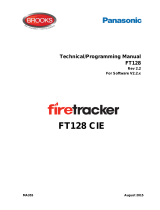 Brooks Firetracker FT128 CIE User manual
Brooks Firetracker FT128 CIE User manual
-
Panasonic Firetracker FT1020G3 CIE User manual
-
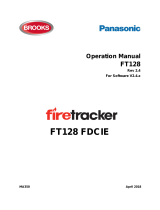 Brooks FT128 User manual
Brooks FT128 User manual
-
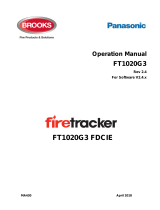 Brooks firetracker FT1020G3 FDCIE User manual
Brooks firetracker FT1020G3 FDCIE User manual
-
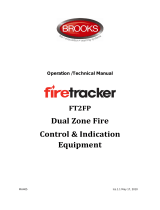 Brooks FireTracker 2-Zone Conventional Control Panel FT2FP User manual
Brooks FireTracker 2-Zone Conventional Control Panel FT2FP User manual
-
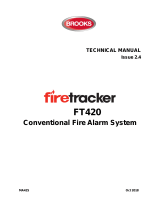 Brooks FireTracker Conventional Panels User manual
Brooks FireTracker Conventional Panels User manual
-
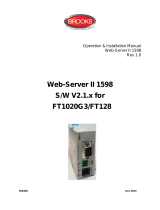 Brooks 1598 User manual
Brooks 1598 User manual
-
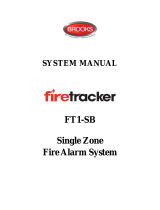 Brooks Firetracker FT1-SB System Manual
Brooks Firetracker FT1-SB System Manual
-
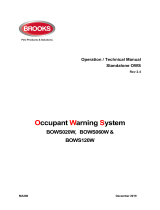 Brooks BOWS020W User manual
Brooks BOWS020W User manual
-
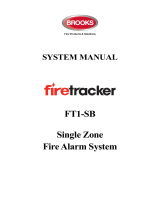 Brooks FireTracker Single Zone Conventional Control Panel FT1-SB User manual
Brooks FireTracker Single Zone Conventional Control Panel FT1-SB User manual
Other documents
-
Kidde SIRIUS TM0109 User manual
-
Transmitter LEDFLADUAL Owner's manual
-
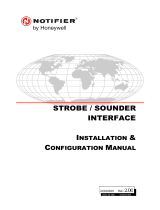 Firesense PCB- User manual
Firesense PCB- User manual
-
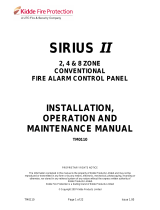 Kidde Fire Systems TM0110 User manual
Kidde Fire Systems TM0110 User manual
-
Comelit ERACLE 16 Operating instructions
-
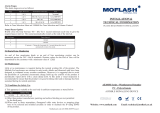 MOFLASH SIGNALLING AE100M Series Installation & Technical Information
MOFLASH SIGNALLING AE100M Series Installation & Technical Information
-
Menvier Security MF9300 Installation And User Instructions Manual
-
Aiphone TW-LCB Wiring Instructions
-
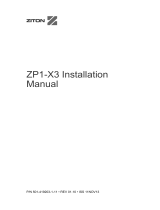 Ziton ZP1-X3 Installation guide
Ziton ZP1-X3 Installation guide
-
HP f550g Car Camcorder Owner's manual






































































